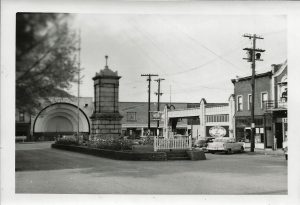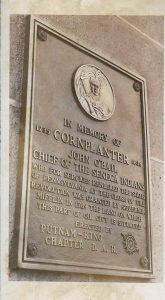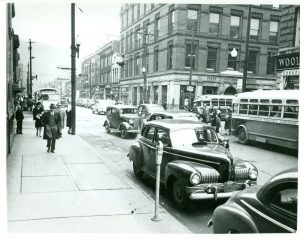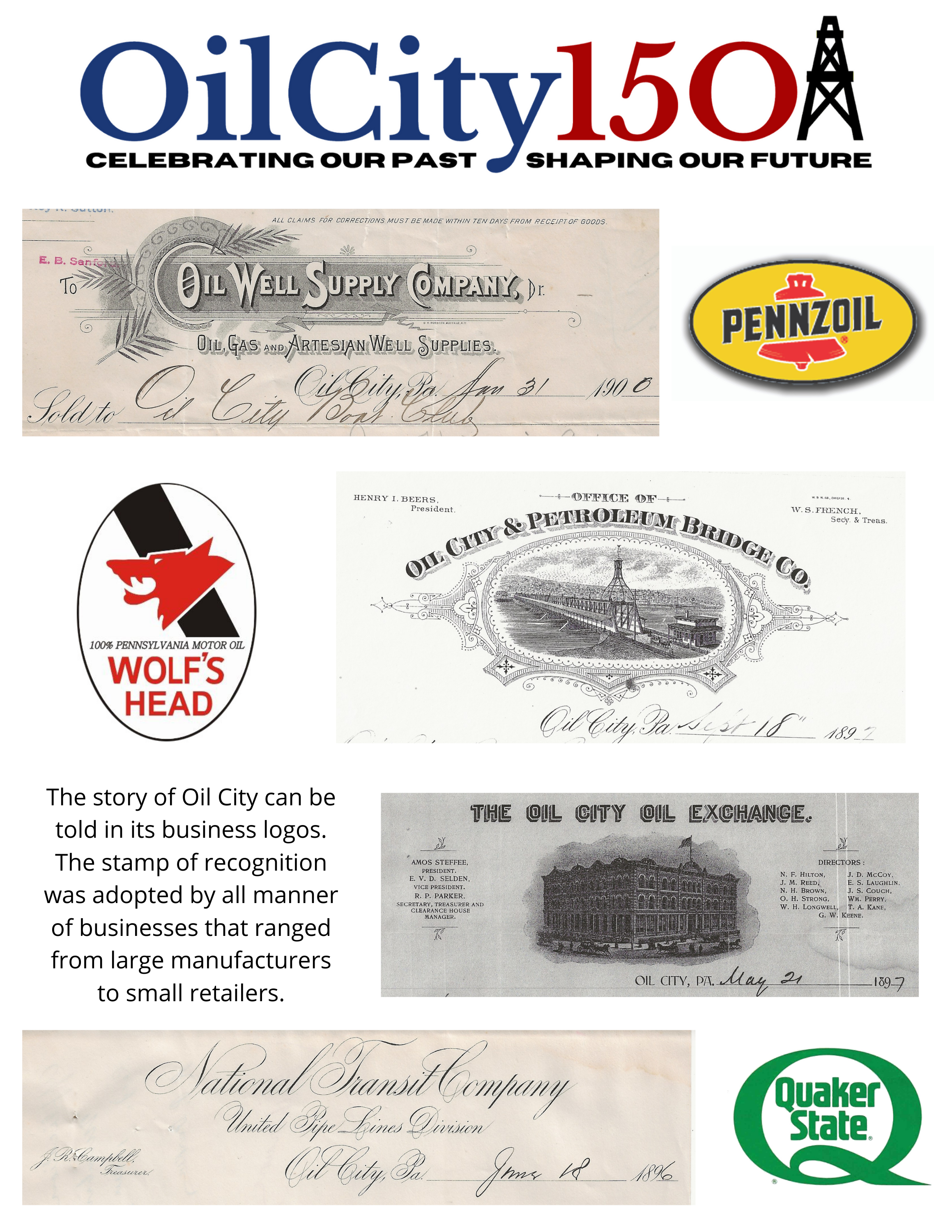A Historic Anniversary
- Judy Etzel
- June 4, 2021
- Hidden Heritage
- 3634

The band shell at the end of Central Avenue in Oil City was named for one of the city’s outstanding military figures, Major General George C. Rickards. In 1882, he established a hardware business in Oil City, later known as Lewis Hardware, and owned it until he entered the U.S Army service in 1916 for duty on the Mexican border. He rose from the ranks as a private in the Pennsylvania National Guard and ended up commanding the 112th Infantry in France during World War I. He later served as the first chief of the U.S. Military Bureau (1921-25). The bandshell, heavily damaged in a fire, was demolished in the mid-1960s.
The City of Oil City, marking its 150th anniversary in 2021 as an incorporated city, owed its early start as a river community that served as a microcosm of the industrial flow and ebb of the region.
There were very few communities in the United States that saw its wealth soar in just a short time. Thanks to the oil boom, great fortunes were made almost over night and the effect lasted for decades.
There is the routine history of a city’s founding. And, there is the quirkiness that accompanied a thriving community.
A Little History
The early inhabitants were Native Americans who were members of the Senecas, a tribe of the Iroquois Confederacy that claimed the entire Allegheny River Valley. With few exceptions, the upper Allegheny was not traveled much by settlers and the river was used mainly by Native Americans and itinerant trappers.
Cornplanter, chief of the Senecas, was awarded much of the land that now makes up Oil City by the Pennsylvania legislature in 1796. He received 303 acres for his role in keeping peace between his people and the early American settlers. By the mid-1820s, the Native Americans had moved out to lands further north. Staying put were a few settlers who tilled small farms and were generally self-sufficient.
 In the early 1800s, the confluence of Oil Creek and the Allegheny River in what is now downtown Oil City saw a booming timber trade because of easy river barge transportation, accessible market and copious amounts of hardwood stands. Sawmills popped up everywhere along the river bank.
In the early 1800s, the confluence of Oil Creek and the Allegheny River in what is now downtown Oil City saw a booming timber trade because of easy river barge transportation, accessible market and copious amounts of hardwood stands. Sawmills popped up everywhere along the river bank.
Another thriving industry soon joined in and it was the iron business. The industry grew rapidly, thanks to the growing city of Pittsburgh downstream that was in great need of iron for its manufacturing plants turning out train rails. What would become Oil City boasted the Oil Creek foundry where iron was fashioned into plow points, stoves and lamps.
Then came oil, courtesy of Col. Drake’s successful well near Titusville. The impact from the 1859 birth of the petroleum industry on the riverbank community was enormous. River travel grew with two-way freight: wood and oil going south and commodities going north to the oil boom towns. Passenger boats, barges, flatboats and steam boats moved up and down the river.
Oil speculators roamed the hills around the growing community. Lots were being laid out along what would become Main Street, a venue described in an April 1865 Harper’s magazine as “a street that contains five or six hotels, all of which are crowded with anxious oil seekers – with all the business being done on one street, the city has a very busy look.”
The City of Oil City was taking shape: the Halyday and Main streets comprised the Borough of Oil City in 1862; oilman William Lay laid out Laytonia in 1863 in the East End; smaller settlements of Albion, Imperial, Downingtown and Lee Town nearby eventually joined with the borough and Laytonia to become Venango City in 1866.
A series of negotiations resulted in a merger of the Borough of Oil City and Venango City in 1871 to create the City of Oil City. Still to come would be Siverlyville in 1910 and West End Borough in 1916.
The city’s population was swelling with Civil War veterans and their families traveling to the oil region to find employment and scores of immigrants from Europe headed to the oil fields to work in the oil fields, manufacturing plants and shops.

Seneca Street was once a two-way street. This 1938 photograph in the Oil City Heritage Society collection shows the busy downtown street in 1938. The imposing building on the corner was the home of First National Bank. It was later reduced in size when the top two floors were removed. On the right is the Woolworth 5-and-10-cent store, later Thrift Drug.
In the same year that the city was incorporated, it had a grand visitor – President Ulysses Grant. At the invitation of the region’s oil barons, he came to thank the industry for playing a vital role in the Civil War. The industry provided refined lubricants to the Union Army as well as a hefty war tax.
Oil City’s booming economy in the late 1800s through the mid-1900s was fueled by the oil and gas industries and its ancillary businesses from banks to manufacturing plants to retailers. Great wealth was pumped into the city. That, in turn, yielded products and people that claimed headlines across the nation and often around the globe. Oil City residents invented things. They influenced the culture. They served their nation. They set world records and much more.
Our people, armed with unique talents, opened the oil fields in Russia as well as Texas. They made and marketed products from glass bottles to pumping jacks. The city was home turf to Quaker State, Wolf’s Head and Pennzoil, companies that at one time claimed two-thirds of all lubricants sold in the U.S. We were truly the Hub of Oildom, even setting the worldwide price of crude oil by the barrel for the world at our downtown Oil Exchange.
The profusion of wealth in Oil City put the region on the map and drew dignitaries and politicians, athletes and entertainers to our city. The visits, from the Emperor of Brazil to presidential candidates, film stars, Buffalo Bill, Mickey Mantle and many more, were due in large part to wealthy city residents who would ante up funds to pay travel expenses and appearance fees. The city boasted an orchestra, numerous bands, semi-pro baseball teams and more.

Alfred Nobel, a Swedish industrialist and inventor of dynamite, came to Oil City in 1879. His brother, Ludwig, was an oil millionaire. Nobel asked Oilwell Supply in Siverly for machinery and technical advice to open the rich Baku oil fields in Russia. Oilwell sent the supplies as well as company driller A.E. Culbertson of Oil City to Russia. The supplies included a steel drilling rig, an innovation designed by Oilwell for use in foreign fields where climate made the use of wooden derricks impractical. According to an Oilwell history, Culbertson married a Russian girl and they raised three children. One of his children, Eli Culbertson became famous as a contract bridge teacher and player in the 1940s. He invented the Culbertson system of bidding. He had relatives living in Siverly.
The promise of jobs both in the petroleum industry as well as in those businesses that would support a rapidly growing population drew many individuals who would eventually go elsewhere to claim fame. For example, Alfred Nobel, founder of the Nobel Prizes and inventor of dynamite, visited the Oil Well Supply plant to tap into talent and technology. Henry J. Heinz, founder of the Heinz food dynasty, came to Oil City in 1863 to manage an ice company for his father. The Hershey family dabbled in retail here until moving to the center of the state. A local man, J.V. Thompson, who made his fortune in the oil industry turned his sights on the coal industry and became known as the Coal Baron, and was considered at that time to be the richest man in the U.S. One local oilman funded the efforts of a man trying to market a ‘writing machine’ that evolved into the Remington typewriter.
We claimed tangible boasting rights, too. The city boasted the longest tunnel in the U.S. ever bored through solid rock. It was located at the base of Hogback Hill and served the Jamestown and Franklin Railroad. The city had two entries in Ripley’s Believe It or Not chronicles – the old Oil City High School that was the only building in the world to have four stories that all had exits to a ground level and the former Bellevue House, a hotel built against a hillside on Main Street that had all front rooms.
The city’s manufacturing plants produced an array of goods, from everything needed to drill and pump an oil well to all manner of pumps. Oil Well Supply could offer a quick change-up and, in times of war, turned out anti-aircraft shells and Tommy gun barrels. National Transit Co. Pump and Machine Co. manufactured the pumps for the Panama Canal. The Oil City Boiler Works made the heating units for Ellis Island. The Mullins Boat Co. made steel boats, including several purchased by King Farouk of Egypt.
The wealth and sophistication of the city’s residents prompted accolades as well as notoriety over the years. Its first 150 years was remarkable in terms of its ingenuity, its culture, its influence, its quirkiness. It has a wonderful legacy to build on.
Written by Judy Etzel with research by Kay Dawson and design by Natalie Cubbon.

The band shell at the end of Central Avenue in Oil City was named for one of the city’s outstanding military figures, Major General George C. Rickards. In 1882, he established a hardware business in Oil City, later known as Lewis Hardware, and owned it until he entered the U.S Army service in 1916 for duty on the Mexican border. He rose from the ranks as a private in the Pennsylvania National Guard and ended up commanding the 112th Infantry in France during World War I. He later served as the first chief of the U.S. Military Bureau (1921-25). The bandshell, heavily damaged in a fire, was demolished in the mid-1960s.
The City of Oil City, marking its 150th anniversary in 2021 as an incorporated city, owed its early start as a river community that served as a microcosm of the industrial flow and ebb of the region.
There were very few communities in the United States that saw its wealth soar in just a short time. Thanks to the oil boom, great fortunes were made almost over night and the effect lasted for decades.
There is the routine history of a city’s founding. And, there is the quirkiness that accompanied a thriving community.
A Little History
The early inhabitants were Native Americans who were members of the Senecas, a tribe of the Iroquois Confederacy that claimed the entire Allegheny River Valley. With few exceptions, the upper Allegheny was not traveled much by settlers and the river was used mainly by Native Americans and itinerant trappers.
Cornplanter, chief of the Senecas, was awarded much of the land that now makes up Oil City by the Pennsylvania legislature in 1796. He received 303 acres for his role in keeping peace between his people and the early American settlers. By the mid-1820s, the Native Americans had moved out to lands further north. Staying put were a few settlers who tilled small farms and were generally self-sufficient.
 In the early 1800s, the confluence of Oil Creek and the Allegheny River in what is now downtown Oil City saw a booming timber trade because of easy river barge transportation, accessible market and copious amounts of hardwood stands. Sawmills popped up everywhere along the river bank.
In the early 1800s, the confluence of Oil Creek and the Allegheny River in what is now downtown Oil City saw a booming timber trade because of easy river barge transportation, accessible market and copious amounts of hardwood stands. Sawmills popped up everywhere along the river bank.
Another thriving industry soon joined in and it was the iron business. The industry grew rapidly, thanks to the growing city of Pittsburgh downstream that was in great need of iron for its manufacturing plants turning out train rails. What would become Oil City boasted the Oil Creek foundry where iron was fashioned into plow points, stoves and lamps.
Then came oil, courtesy of Col. Drake’s successful well near Titusville. The impact from the 1859 birth of the petroleum industry on the riverbank community was enormous. River travel grew with two-way freight: wood and oil going south and commodities going north to the oil boom towns. Passenger boats, barges, flatboats and steam boats moved up and down the river.
Oil speculators roamed the hills around the growing community. Lots were being laid out along what would become Main Street, a venue described in an April 1865 Harper’s magazine as “a street that contains five or six hotels, all of which are crowded with anxious oil seekers – with all the business being done on one street, the city has a very busy look.”
The City of Oil City was taking shape: the Halyday and Main streets comprised the Borough of Oil City in 1862; oilman William Lay laid out Laytonia in 1863 in the East End; smaller settlements of Albion, Imperial, Downingtown and Lee Town nearby eventually joined with the borough and Laytonia to become Venango City in 1866.
A series of negotiations resulted in a merger of the Borough of Oil City and Venango City in 1871 to create the City of Oil City. Still to come would be Siverlyville in 1910 and West End Borough in 1916.
The city’s population was swelling with Civil War veterans and their families traveling to the oil region to find employment and scores of immigrants from Europe headed to the oil fields to work in the oil fields, manufacturing plants and shops.

Seneca Street was once a two-way street. This 1938 photograph in the Oil City Heritage Society collection shows the busy downtown street in 1938. The imposing building on the corner was the home of First National Bank. It was later reduced in size when the top two floors were removed. On the right is the Woolworth 5-and-10-cent store, later Thrift Drug.
In the same year that the city was incorporated, it had a grand visitor – President Ulysses Grant. At the invitation of the region’s oil barons, he came to thank the industry for playing a vital role in the Civil War. The industry provided refined lubricants to the Union Army as well as a hefty war tax.
Oil City’s booming economy in the late 1800s through the mid-1900s was fueled by the oil and gas industries and its ancillary businesses from banks to manufacturing plants to retailers. Great wealth was pumped into the city. That, in turn, yielded products and people that claimed headlines across the nation and often around the globe. Oil City residents invented things. They influenced the culture. They served their nation. They set world records and much more.
Our people, armed with unique talents, opened the oil fields in Russia as well as Texas. They made and marketed products from glass bottles to pumping jacks. The city was home turf to Quaker State, Wolf’s Head and Pennzoil, companies that at one time claimed two-thirds of all lubricants sold in the U.S. We were truly the Hub of Oildom, even setting the worldwide price of crude oil by the barrel for the world at our downtown Oil Exchange.
The profusion of wealth in Oil City put the region on the map and drew dignitaries and politicians, athletes and entertainers to our city. The visits, from the Emperor of Brazil to presidential candidates, film stars, Buffalo Bill, Mickey Mantle and many more, were due in large part to wealthy city residents who would ante up funds to pay travel expenses and appearance fees. The city boasted an orchestra, numerous bands, semi-pro baseball teams and more.

Alfred Nobel, a Swedish industrialist and inventor of dynamite, came to Oil City in 1879. His brother, Ludwig, was an oil millionaire. Nobel asked Oilwell Supply in Siverly for machinery and technical advice to open the rich Baku oil fields in Russia. Oilwell sent the supplies as well as company driller A.E. Culbertson of Oil City to Russia. The supplies included a steel drilling rig, an innovation designed by Oilwell for use in foreign fields where climate made the use of wooden derricks impractical. According to an Oilwell history, Culbertson married a Russian girl and they raised three children. One of his children, Eli Culbertson became famous as a contract bridge teacher and player in the 1940s. He invented the Culbertson system of bidding. He had relatives living in Siverly.
The promise of jobs both in the petroleum industry as well as in those businesses that would support a rapidly growing population drew many individuals who would eventually go elsewhere to claim fame. For example, Alfred Nobel, founder of the Nobel Prizes and inventor of dynamite, visited the Oil Well Supply plant to tap into talent and technology. Henry J. Heinz, founder of the Heinz food dynasty, came to Oil City in 1863 to manage an ice company for his father. The Hershey family dabbled in retail here until moving to the center of the state. A local man, J.V. Thompson, who made his fortune in the oil industry turned his sights on the coal industry and became known as the Coal Baron, and was considered at that time to be the richest man in the U.S. One local oilman funded the efforts of a man trying to market a ‘writing machine’ that evolved into the Remington typewriter.
We claimed tangible boasting rights, too. The city boasted the longest tunnel in the U.S. ever bored through solid rock. It was located at the base of Hogback Hill and served the Jamestown and Franklin Railroad. The city had two entries in Ripley’s Believe It or Not chronicles – the old Oil City High School that was the only building in the world to have four stories that all had exits to a ground level and the former Bellevue House, a hotel built against a hillside on Main Street that had all front rooms.
The city’s manufacturing plants produced an array of goods, from everything needed to drill and pump an oil well to all manner of pumps. Oil Well Supply could offer a quick change-up and, in times of war, turned out anti-aircraft shells and Tommy gun barrels. National Transit Co. Pump and Machine Co. manufactured the pumps for the Panama Canal. The Oil City Boiler Works made the heating units for Ellis Island. The Mullins Boat Co. made steel boats, including several purchased by King Farouk of Egypt.
The wealth and sophistication of the city’s residents prompted accolades as well as notoriety over the years. Its first 150 years was remarkable in terms of its ingenuity, its culture, its influence, its quirkiness. It has a wonderful legacy to build on.
Written by Judy Etzel with research by Kay Dawson and design by Natalie Cubbon.

